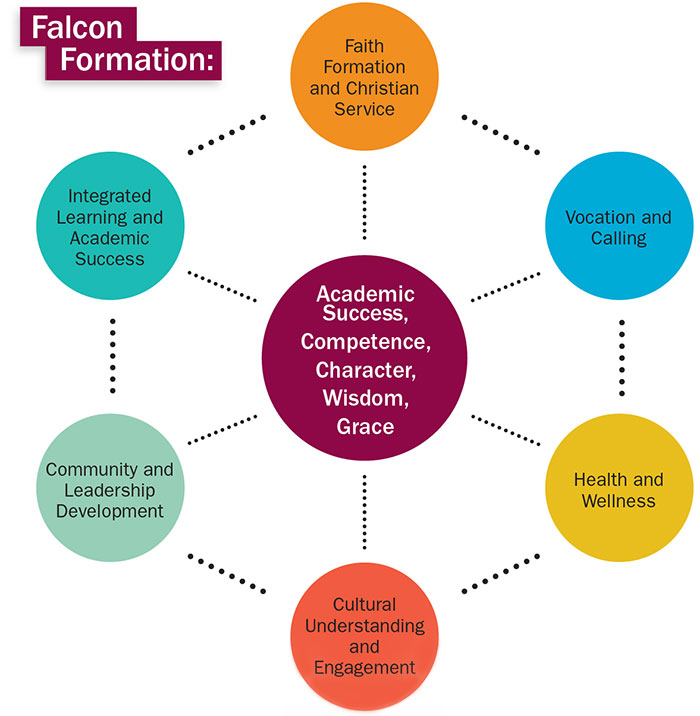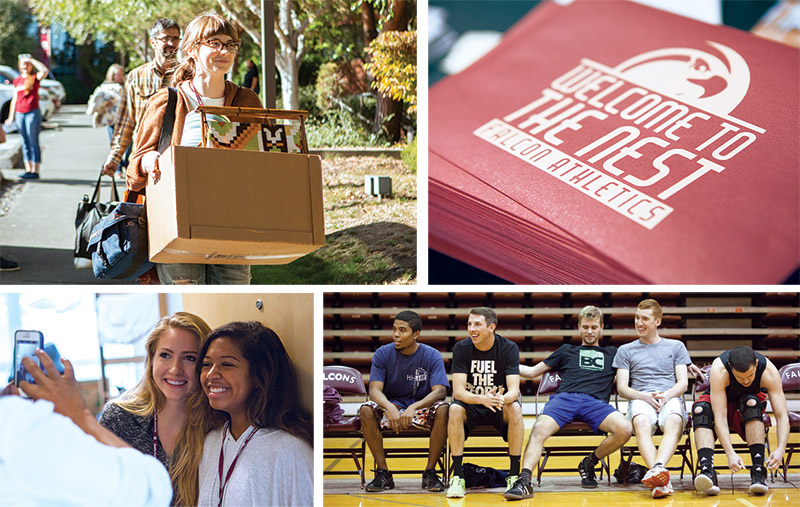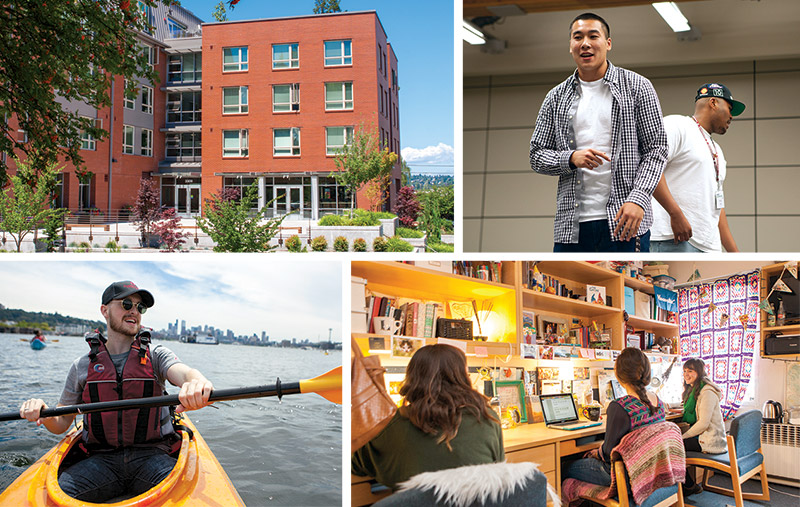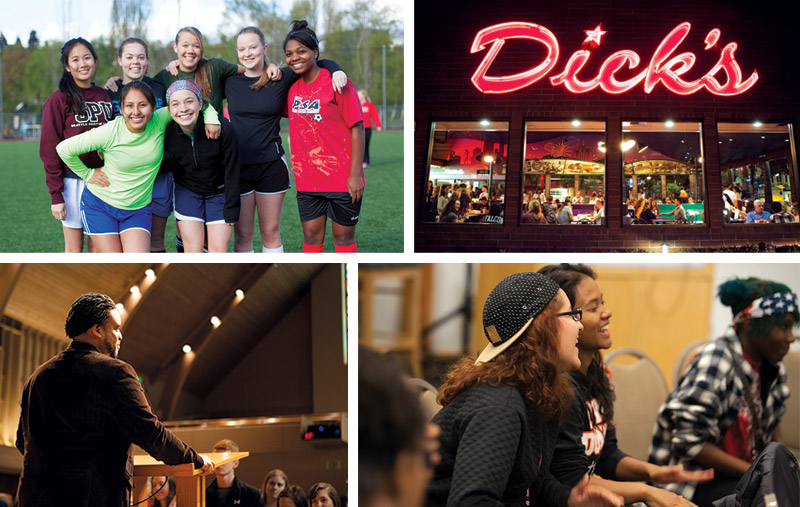Senior Nakaira Petty learned one of her big college life lessons outside of the classroom.
Petty was president of After Choir Flava’, a campus worship dance club, for two years, but started to realize that she would rather have a backstage role than direct leadership. She had a hard time with conflict and sometimes waited too long to confront problems among club members.
“There were times we could be friends, and times I needed to be club leader,” she says. “It was hard for me to express that.”
This year, Petty is using her experiences to pursue another kind of leadership. As coordinator for Seattle Pacific University’s 60-some student clubs, she will support club leaders by helping them network and publicize events, but won’t lead any of her own.
While not all Seattle Pacific students lead clubs, they can relate to Petty’s experience — there are countless lessons about interpersonal relationships and leadership waiting at the shared sinks in residence hall bathrooms, in balled-up clothes piling up on the other person’s side of a shared room, or (in the past) tracking down teammates to ante up payment to join an intramural league.
These “co-curricular” experiences outside of the classroom are integral to the University. And that’s intentional, says Jeff Jordan, vice president for Student Life.
“The SPU campus community is more than a place to sleep, eat, or work out. If it were just those things, we could outsource to the Hilton,” he says. “When you become part of the SPU community, you can expect to be involved in holistic learning outside the classroom.”
The student life aspect of this co-curricular focus, called “Falcon Formation,” is a way of defining what’s unique about being a part of the SPU community, and how those qualities shape students’ lives (see graphic on page 37).
As Falcon Formation is implemented over the next few years, students won’t see dramatic changes, Jordan says. They should find that wellness, vocation, and roommate decisions like sleeping arrangements work together smoothly to enhance classroom learning with things like talks about healthy eating and self-care, or vocational workshops to help students think through choices about majors or careers.

Falcon Formation (above) aims to unite
every aspect of student life at SPU to create
graduates who are
competent, character-
filled, wise, gracious, and successful.
 Students move in, take
photos in residence halls, and prepare to
play in Royal Brougham Pavilion.
Students move in, take
photos in residence halls, and prepare to
play in Royal Brougham Pavilion.
Sharing bedrooms can be the first foreign experience students face on campus: Recent research by the Association of College and University Housing Officers International found that nine out of 10 freshmen have never shared a bedroom before their first year of college.
At SPU, the close quarters in residence halls are intentional — designed to break down barriers and create community. Student investment makes residence hall life work, but the buildings are also designed with community in mind, Jordan says.
Arnett Hall, the newest residence hall on campus, is an L-shaped building with elevators and an inviting staircase in the elbow of the L, where the kitchen, TV lounges, and study areas are also located. Doors to individual rooms prop open so students can talk to each other across the hallway or gather for impromptu study sessions.
“Community in residence halls is extremely important,” Jordan says. “Making sure there’s a reason for people to bond together is still the bread and butter of residence life.”
Junior Naomi Allen says she's an introvert who found the communal bathrooms and lack of private time tough at first, but she now is grateful for the connections she made through dorm life.
“The open-door policy shocked me,” she says. “But it's a really great way to meet people.”
Junior Diana Cabrera is a leader with Early Connections, SPU's Orientation program for freshmen who are ethnically diverse, from diverse urban areas, or firstgeneration college students. Cabrera lives in Emerson Hall this year and says she loves the unique traditions of each floor. Cabrera has lived on Fourth East Emerson and Third Moyer, and her floors have visited pumpkin patches, gone on scavenger hunts, and shared life stories with each other.
“By the end of the year, you’re so comfortable with each other that everyone has their doors open and you can just go in and hang out,” she says.
Over the past 10 years, Seattle Pacific has intentionally worked to increase the diversity of the entering class. As a result, racial diversity at the University has increased — this year, 35 percent of incoming students are nonwhite, up from less than 10 percent in the entering class a decade ago. But for students like Adrian De Jesus, who is Filipino-American, campus still feels very different from their home communities.
De Jesus’ family lives in Renton, where white non-Hispanic and non-Latino people comprise less than half of the population. The nursing student joined the Filipino American Student Association — which he is leading this year — soon after coming to campus.
“I looked for people like me and felt comfortable there,” he says. “Once I found that, it was easy for me to branch out into the school culture.”
New community, new classmates, and new opportunities can make college life stressful. Susan Okamoto Lane, dean of Seattle Pacific’s multi-ethnic and wellness programs, wants to teach students how to recognize and respond to that stress.
“I’m hoping that students will understand, ‘When I get stressed, this is what it looks like; these are my unhealthy fallback behaviors, and this is what I can do to take care of myself,’” she says.
Okamoto Lane oversees a wellness initiative component of Falcon Formation, aimed at helping students manage their own mental and physical health. To her, it’s a life lesson as important as the biblical and theological competency the University emphasizes.
“For college students, there’s a sense of invulnerability — ‘I can stay up all night and eat a bunch of junk food and it won’t be a big deal,’” says Okamoto Lane. “But the habits that students start to develop in college have a direct impact on their learning and relationships, and carry long-term effects.”
Physical fitness is one such habit, and Intramural Program Director Adam Finch ’02 is energetic about it. Since Finch took over the program in 2012, the number of students participating in intramurals has tripled. Last spring quarter alone, more than 900 students participated in 18 programs. This year, a new student activities fee gives all students access to the program and funds upkeep of gym facilities.
 SPU's newest residence
hall, Arnett Hall, was designed to
encourage community with L-shaped hallways
and common areas near central elevators
and stairways. Students at SPU
bond over traditions like Early
Connections’ Open Mic night, kayak trips
on Lake Union, and homework breaks.
SPU's newest residence
hall, Arnett Hall, was designed to
encourage community with L-shaped hallways
and common areas near central elevators
and stairways. Students at SPU
bond over traditions like Early
Connections’ Open Mic night, kayak trips
on Lake Union, and homework breaks.
Senior Tanner Dalgardno knew he wanted to join intramurals before he even got to campus. He took his whole floor along with him, signing them up for intramurals in every sport possible. The team failed at basketball, but had a blast. “We lost every basketball game by like, 52 points,” he says. “But it was fun, because it was our floor, and we got to know each other.” Intramurals work when students are involved as leaders and the program responds to their needs, Finch says. Last year, he tried game-night tournaments in the residence halls. Settlers of Catan was a success (he’s bringing it back in the winter), while a few other games were less popular. But whether a particular activity is a hit or not, Finch can still achieve his goal. “Intramurals is just another place where people get invited to a team,” he says. “After that experience, they have that many more people in their community. It helps make our campus smaller. It lets students share life together.”
 From intramural sports to
Orientation traditions
involving local haunts to
attending chapel, everything
SPU students do is
designed to create a
community of people who
know how to live lives
informed by “a Christian
narrative.”
From intramural sports to
Orientation traditions
involving local haunts to
attending chapel, everything
SPU students do is
designed to create a
community of people who
know how to live lives
informed by “a Christian
narrative.”
There’s one Falcon Formation objective that infuses all the others: faith formation and Christian service.
“We want a fully formed person: One whose mind is fully devoted to God,” says interim University Chaplain Bo Lim. “That translates to how students live and take care of their bodies, what their relationships look like, how they interact in those relationships, and their vocations.”
While SPU students are not required to sign any faith statement to attend, they must take three theology classes during their time at the University, and — like all aspects of Falcon Formation — co-curricular programs should add to a holistic faith experience for students, Lim says. The Office of University Ministries recently united the John Perkins Center for Reconciliation, Leadership Training, and Community Development and the Campus Ministries program to better convey the message that personal faith should not be separated from outreach and reconciliation work.
SPU doesn’t mandate chapel, but Lim and the Office of University Ministries this year are encouraging faculty, staff, and student leaders to attend at least three times each quarter. And thanks to a 2014 Vision and Call Grant from the Murdock Charitable Trust, SPU in 2014 introduced Wesleyan small groups to University Foundations 1000 courses — a small program that, hopefully, will grow to include every incoming freshman, encouraging students to create and experience Christian community at Seattle Pacific, says Lim.
The goal is for students to leave SPU understanding faith intellectually and relationally, and to have tools to integrate faith with every aspect of life.
“The last thing we want to do in ministries is get students into a holy huddle,” Lim says. “Our desire would be that every aspect of student life is empowered by, embedded in, and informed by a Christian narrative. If a student’s expression of faith is on the basketball court, I want that to flourish.”